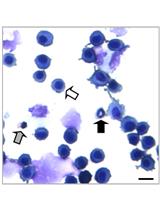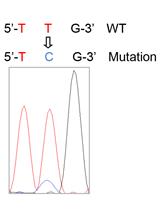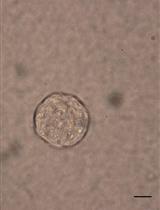- EN - English
- CN - 中文
A Fast and Reliable Method to Generate Pure, Single Cell-derived Clones of Mammalian Cells
一种快速可靠的生成纯的、单细胞衍生的哺乳动物细胞克隆的方法
(*contributed equally to this work) 发布: 2022年08月20日第12卷第16期 DOI: 10.21769/BioProtoc.4490 浏览次数: 3384
评审: Ralph Thomas BoettcherJungeun YuAnonymous reviewer(s)
Abstract
Stable cell cloning is an essential aspect of biological research. All advanced genome editing tools rely heavily on stable, pure, single cell-derived clones of genetically engineered cells. For years, researchers have depended on single-cell dilutions seeded in 96- or 192-well plates, followed by microscopic exclusion of the wells seeded with more than or without a cell. This method is not just laborious, time-consuming, and uneconomical but also liable to unintentional error in identifying the wells seeded with a single cell. All these disadvantages may increase the time needed to generate a stable clone. Here, we report an easy-to-follow and straightforward method to conveniently create pure, stable clones in less than half the time traditionally required. Our approach utilizes cloning cylinders with non-toxic tissue-tek gel, commonly used for immobilizing tissues for sectioning, followed by trypsinization and screening of the genome-edited clones. Our approach uses minimal cell handling steps, thus decreasing the time invested in generating the pure clones effortlessly and economically.
Graphical abstract:

A schematic comparison showing the traditional dilution cloning and the method described here. Here, a well-separated colony (in the green box) must be preferred over the colonies not well separated (in the red box).
Background
Genetically engineered expression and genome manipulating plasmids are routinely utilized (Soutoglou and Misteli, 2008; Toiber et al., 2013; Simon et al., 2019). Studies involving the characterization of cellular localization, or recruitment of a factor to a cell organelle under basal or induced conditions, depend on a short-lasting ectopic expression of the desired gene (Soutoglou and Misteli, 2008). However, modern biological processes and physiological studies involve long-term characterization, requiring stable cell lines expressing or inhibiting the function of a specific gene or cluster of genes (Condreay et al., 1999). In addition, the varying percentage of transfected cells also generates a wide range of undesired experimental variation. Thus, the generation of pure lines of genetically engineered cells is essential in studying any given protein's function more accurately and reproducibly.
Over the decades, several ways have been devised to generate genetically engineered pure cells (Condreay et al., 1999; Aranda et al., 2014; Giuliano et al., 2019; Singh, 2019). Dilution cloning and fluorescence-activated cell sorting (FACS) are the most commonly used (Giuliano et al., 2019; Singh, 2019). However, both these techniques have their advantages and disadvantages. Dilution cloning is the cheapest method to generate stable cell lines, as it does not involve unique and expensive instrumentation (Singh, 2019). However, this technique is very time-consuming and highly laborious. Indeed, many scientists spend a considerable amount of time each day identifying and marking the wells in a 96-well plate showing colony growth from a single cell, and marking the wells that receive multiple or no cells. Similarly, as an alternative to dilution cloning, FACS requires advanced sorting instrumentation and a sorting expert. In addition, FACS can sometimes be stressful for cells, thus altogether challenging the desired outcome.
To overcome these drawbacks, we generated a simple and easy method for generating stable, single cell-derived clones of anchorage-dependent cells. This method neither involves a labor-intensive step nor expensive instrumentation. Our protocol utilizes the inherent property of the cells to attach to the tissue culture (TC) surface and the use of a selection marker to identify and then select the desired cells. Over time, the stable cells that survive the selection will be from a small colony. These colonies will be refined by encircling them with a cloning cylinder and a non-toxic gel. Considering the innovative design, simple steps, and ease of applicability, any cell culture-trained personnel can follow this method for generating stable cells. The protocol presented is labor-saving and economical, with high reproducibility in developing pure, stable, single cell-derived clones, suitable for long-term and extensive scale up use in subsequent experiments.
Materials and Reagents
Materials
6-well clear flat bottom TC-treated multiwell cell culture plate (Gibco, catalog number: 353046)
100 mm TC-treated cell culture dish (Corning, Falcon, catalog number: 353003)
150 mm Nunc EasYDish culture dish (Thermo, catalog number: 150468)
T75 TC flask (Greiner Cell STAR T75, catalog number: 658170)
15 mL centrifuge tube, conical bottom sterile (Corning, Falcon, catalog number: 352099)
Cryogenic vials, 1.2 mL (Corning, catalog number: 430487)
1.5 mL tubes (Sarstedt, catalog number: 72.690.301)
Pyrex Cloning Cylinders (Corning, catalog number: 3166-10)
Pipette tips 10–200 µL (Greiner bio-one, catalog number: GB775362)
Micropipette (Thermo scientific, Finnpipette F1, catalog number: GJ06928)
Universal permanent marker pen (Schneider, catalog number: Maxx 222)
Artis Tweezer (Sigma, catalog number: 18072ARS)
Reagents
0.05% Trypsin-EDTA (PAN Biotech, catalog number: P10-040100)
Puromycin (Invivo Gen, catalog number: ant-pr-1)
Turbofect® Transfection reagent (Thermo Scientific, catalog number: R0531)
DMEM (1×, Gibco, catalog number: 31885-023)
Dimethyl sulfoxide (DMSO; Thermo Scientific, catalog number: 85190)
Dulbecco's Phosphate buffered saline without Ca and Mg (Sigma, catalog number: D8537-500ML)
pSp-Cas9(BB)-2A-Puro (PX459) V2.0 Plasmid (Addgene, catalog number: 62988)
SIRT1 gRNA (CAACAGGTTGCGGGAATCCAA) (Sigma; Oligo: 8815731198-000040)
Tissue-Tek® O.C.T. Compound (Sakura, catalog number: 4583)
Protein assay dye concentrate (Biorad, catalog number 5000006)
Anti-SIRT1 antibody (Cell Signaling, catalog number: 9475S)
Anti-β-Actin antibody (Cell Signaling, catalog number: 8457S)
Anti-Rabbit-IgG HRP conjugated (Cell Signaling, catalog number: 7074)
Hemocytometer (Sigma, catalog number: Z359629)
Penicillin/Streptomycin (Pan Biotech, catalog number: P06-07100)
Fetal bovine serum (FBS), Heat Inactivated (Gibco, catalog number: A38401-02)
L-Glutamine (Pan Biotech, catalog number: P04-80100)
Protease inhibitor cocktail 100× (Cell Signaling, catalog number: 5871)
Plasmid preparation Kit (Qiagen, catalog number: 12362)
Glycine (Sigma, catalog number: G8898)
Tris-Base (Trizma; Sigma, catalog number: T1503)
EDTA (Acros, catalog number: 147850010)
Tween-20 (Sigma, catalog number: P9416)
Glycerol (Honeywell, catalog number: 15523)
Sodium dodecyl sulfate (SDS; Bio-Rad, catalog number: 161-0302)
Bromophenol blue (BPB; Merck, catalog number: 1.08122.0005)
Dithiothreitol (DTT; Sigma, catalog number: D9779)
β-Mercaptoethanol (β-ME; Sigma, catalog number: M3148)
Mini-Protean TGX Gels (Bio-Rad, catalog number: 4561094)
Color Prestained protein standard marker (Cell Signaling, catalog number: P7719S)
Solutions and Media
Tris-Glycine SDS-PAGE running buffer (5×) (see Recipes)
Lysis buffer (see Recipes)
Basal cell culture medium (see Recipes)
Cell freezing medium (see Recipes)
5× SDS PAGE Loading dye or Laemmli’s buffer (see Recipes)
Equipment
TC incubator (Binder,model: CB 170, catalog number: 9640-0009)
Refrigerated benchtop centrifuge (Sigma, model: 3-18KS, rotor number: 11133)
Refrigerated Microcentrifuge (Eppendorf, model: 5430 R, rotor number: FA-45-30-11)
Ultra-low freezer (Thermo Scientific, catalog number: TSX60086D)
Liquid Nitrogen storage (Wharton, model: K-Series)
Compound Microscope (Wilovert, Hund Wetzlar, catalog number: 008.0309.0)
Procedure
文章信息
版权信息
© 2022 The Authors; exclusive licensee Bio-protocol LLC.
如何引用
Han, Z., Madhavan, B. K., Kaymak, S., Nawroth, P. and Kumar, V. (2022). A Fast and Reliable Method to Generate Pure, Single Cell-derived Clones of Mammalian Cells. Bio-protocol 12(16): e4490. DOI: 10.21769/BioProtoc.4490.
分类
癌症生物学 > 通用技术 > 细胞生物学试验
细胞生物学 > 细胞分离和培养 > 单层培养
您对这篇实验方法有问题吗?
在此处发布您的问题,我们将邀请本文作者来回答。同时,我们会将您的问题发布到Bio-protocol Exchange,以便寻求社区成员的帮助。
提问指南
+ 问题描述
写下详细的问题描述,包括所有有助于他人回答您问题的信息(例如实验过程、条件和相关图像等)。
Share
Bluesky
X
Copy link












